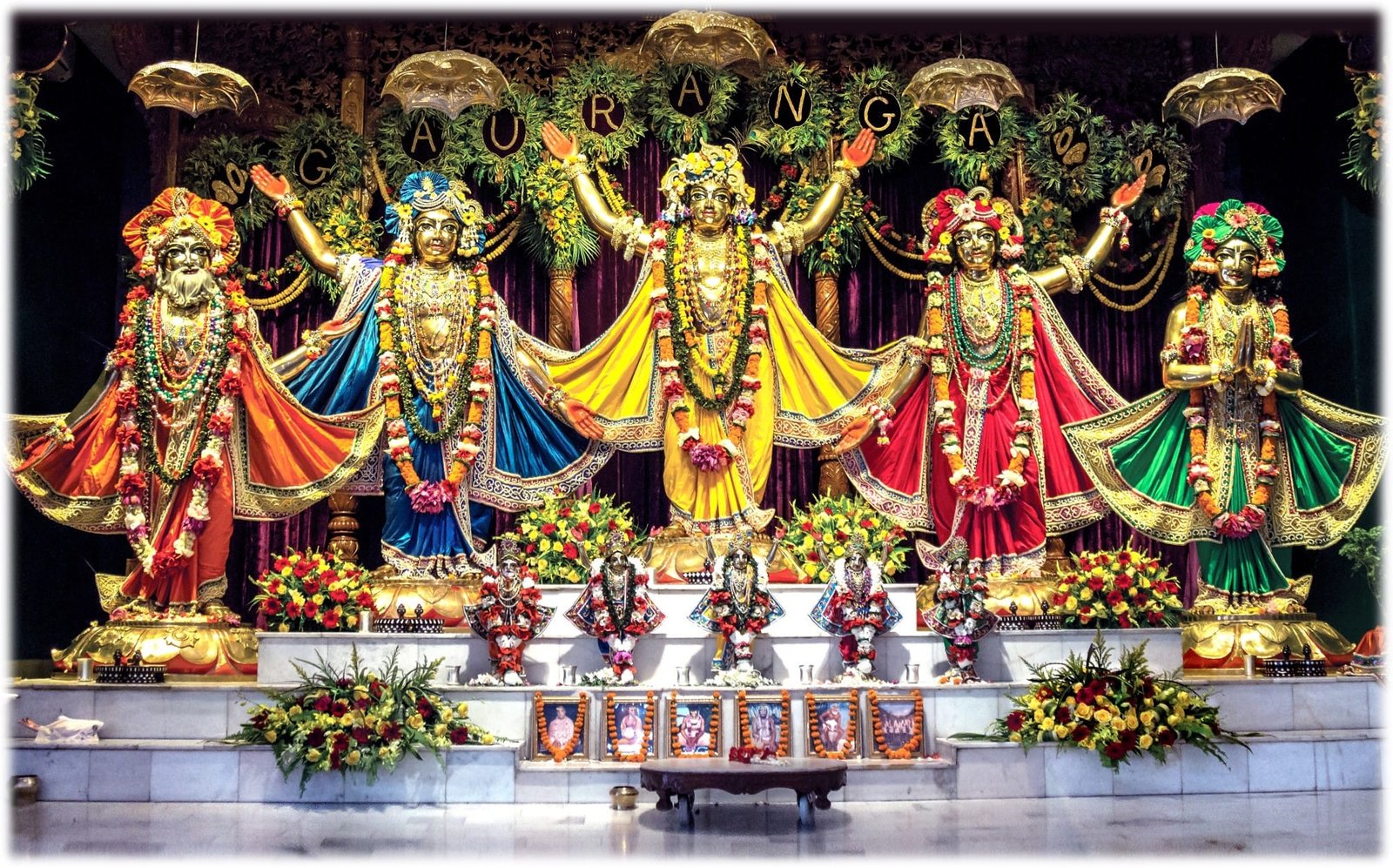
Sri Sri Panca-Tattva
(jaya) sri-krishna-caitanya prabhu nityananda
sri-advaita gadadhara srivasadi-gaura-bhakta-vrinda
Sri Caitanya Mahaprabhu is always accompanied by His plenary expansion Sri Nityananda Prabhu, His incarnation Sri Advaita Prabhu, His internal potency Sri Gadadhara Prabhu, and His marginal potency Srivasa Prabhu. He is in the midst of them as the Supreme Personality of Godhead. One should know that Sri Caitanya Mahaprabhu is always accompanied by these other tattvas. Therefore our obeisances to Sri Caitanya Mahaprabhu are complete when we say, sri-krishna-caitanya prabhu nityananda sri-advaita gadadhara srivasadi-gaura-bhakta-vrinda. As preachers of the Krishna consciousness movement, we first offer our obeisances to Sri Caitanya Mahaprabhu by chanting this Panca-tattva mantra; then we say,
Hare Krishna, Hare Krishna, Krishna Krishna, Hare Hare
Hare Rama, Hare Rama, Rama Rama, Hare Hare.
namo mahā-vadānyāya kṛṣṇa-prema-pradāya te
kṛṣṇāya kṛṣṇa-caitanya- nāmne gaura-tviṣe namaḥ
O most munificent incarnation! You are Kṛṣṇa Himself appearing as Śrī Kṛṣṇa Caitanya Mahāprabhu. You have assumed the golden color of Śrīmatī Rādhārāṇī, and You are widely distributing pure love of Kṛṣṇa. We offer our respectful obeisances unto You.
(CC Madhya 19.53)
pañca-tattvātmakaṁ kṛṣṇaṁ bhakta-rūpa-svarūpakam
bhaktāvatāraṁ bhaktākhyaṁ namāmi bhakta-śaktikam
I offer my obeisances unto the Supreme Lord, Kṛṣṇa, who is nondifferent from His features as a devotee, devotional incarnation, devotional manifestation, pure devotee and devotional energy.
(CC Adi 1.14)
In his Anubhāṣya, Śrī Bhaktisiddhānta Sarasvatī Ṭhākura, describing the truth about the Pañca-tattva, explains that we should understand that Lord Śrī Caitanya Mahāprabhu is the supreme predominator and that Nityānanda Prabhu and Advaita Prabhu are His subordinates but are also predominators. Lord Śrī Caitanya Mahāprabhu is the Supreme Lord, and Nityānanda Prabhu and Advaita Prabhu are manifestations of the Supreme Lord. All of Them are viṣṇu-tattva, the Supreme, and are therefore worshipable by the living entities. Although the other two tattvas within the category of Pañca-tattva—namely, śakti-tattva and jīva-tattva, represented by Gadādhara and Śrīvāsa—are worshipers of the Supreme Lord, they are in the same category because they eternally engage in the transcendental loving service of the Lord.
(CC Adi 7.15 purport)
Let me offer my obeisances unto Lord Śrī Kṛṣṇa, who has manifested Himself in five as a devotee, expansion of a devotee, incarnation of a devotee, pure devotee and devotional energy.
(CC Adi 7.6)
Lord Śrī Kṛṣṇa Caitanya is Kṛṣṇa [Vrajendra-kumāra], the embodiment of rasas. He is amorous love personified. (CC Adi 4.222)
Balarāma appeared with Him as Lord Nityānanda. (CC Adi 5.6)
Lord Advaita Ācārya is the incarnation of Mahā-Viṣṇu. (CC Ādi 6.4)
Gadādhara Paṇḍita is simultaneously an incarnation of Śrīmatī Rādhārāṇī and Lalitā-sakhī. (CC Adi 10.15)
Śrīvāsa Paṇḍita was an incarnation of Nārada Muni. (CC Adi 12.65)
In distributing love of Godhead, Caitanya Mahāprabhu and His associates did not consider who was a fit candidate and who was not, nor where such distribution should or should not take place. They made no conditions. Wherever they got the opportunity, the members of the Pañca-tattva distributed love of Godhead.
(CC Adi 7.23)
The more the five members of the Pañca-tattva cause the rains of love of Godhead to fall, the more the inundation increases and spreads all over the world.
(CC Adi 7.28)
The yogīs should contemplate with full devotion the compassionate glances frequently cast by the Lord’s eyes, for they soothe the most fearful threefold agonies of His devotees. His glances, accompanied by loving smiles, are full of abundant grace.
(SB 3.28.31)
So all these persons associated with Kṛṣṇa, Śrī Kṛṣṇa Caitanya, Śrī Nityānanda, Śrī Advaita, and Gadādhara and Śrīvāsa, all of them, they are one. One in this sense: they are all interested how to push on Kṛṣṇa consciousness. Śrī Kṛṣṇa Caitanya Mahāprabhu, He’s trying personally, the Supreme Personality of Godhead. And Nityānanda Prabhu, Advaita Prabhu, Śrīvāsa, Gadādhara, they are trying to help. So . . . and to approach all these five supreme persons, you require the help of guru. Therefore the guru is offered first the respectful prayers, vande gurūn. And gurūn, bahu-vacana, plural number, that many gurus. But they are not many; they are one, guru-tattva. Just like Kṛṣṇa has many forms, but that does not mean Kṛṣṇa is different. No. Kṛṣṇa is one. Similarly, guru, there may be many gurus, it doesn’t matter, but their philosophy must be one: to teach everyone that Kṛṣṇa is the Supreme Personality of Godhead.
(750325 – Lecture CC Adi 01.01 – Mayapur)
Information – In Srila Prabhupada’s Centennial Year, 1996, Māyāpur Candrodaya Mandir would undergo another change in Deity worship with the arrival of Sri Pañca-tattva (Small), and the temple expanded yet again to accommodate Them. Their worship commenced on Gaura-pūrṇimā of that year.
But the most amazing change was yet to come: the arrival in 2004 of the big Pañca-tattva Deities. That event saw a new era commence in ISKCON. “When Radha-Madhava were installed, there were definitely feelings of transcendence,” Jananivasa says. “When we went up to instal the chakra after They were installed, you could feel They were manifesting something. But nothing like the installation of Pañca-tattva. Even before They were installed, there was so much mercy there.” Both installations were many years apart. Was this, then, a maturation of devotional sentiment, or the mercy of the Lord?
“I would say it was an act of mercy, of Their sweet will,” Jananivasa says. “We had fulfilled a desire of Srila Prabhupada’s to bring these Deities, and the overwhelming feelings that everyone experienced was Śri Panca-tattva manifesting Their presence.”
Worldwide, devotees felt that merciful glance of Śri Caitanya Mahaprabhu and His associates; they experienced the abundant grace that emanates from the Deity form of the Lord, and all were swept up in an unmistakable shower of love of God. Jananivāsa concludes, “It’s not something you can create. It’s something that, no matter how hard you try, you can’t produce it. Grace comes of it’s own accord.”
Śrīla Prabhupada said, ‘Lord Caitanya should be seven feet tall and covered with gold,’ and I said, ‘Oh, not marble?’ Prabhupāda said, ‘No, They should be aṣṭa-dhātu.’
(‘Article Full of Abundant Grace’ by Braja Sevaki dasi, Mayapur Magazine 2006)
Śrī Caitanya Mahāprabhu appeared here at Māyāpur, this very place where you are now sitting, with all these five features: Nityānanda Prabhu, Śrī Advaita Prabhu and Gadādhara Prabhu, Śrīnivāsa Prabhu. So He Himself, Kṛṣṇa, and Nityānanda Prabhu is immediate expansion of His personal self—Advaita Prabhu is incarnation of Kṛṣṇa, or Viṣṇu, Mahāviṣṇu, three; and Gadādhara Prabhu is the expansion of spiritual energy; and Śrīnivāsa Prabhu is the expansion of His marginal potency, marginal energy, jīva-tattva. Jīva-tattva, śakti-tattva, prakāśa-tattva, and avatāra-tattva, and He Himself. This pañca-tattva.
(740303 - Lecture CC Adi 07.03 - Mayapur)
Just like Lord Caitanya Mahāprabhu, His personal expansion is Nityānanda Prabhu and Advaita Prabhu. And Śrīvāsādi, they are separated expansion.
Although they are associates, but Śrīvāsa, jīva-tattva; and Nityānanda Prabhu and Advaita Prabhu, viṣṇu-tattva. And Gadādhara is śakti-tattva. So in this way, God is person, and His personal expansions are innumerable, unlimited. The viṣṇu-tattva, They are worshipable. And other tattva, śakti-tattva and jīva-tattva, they are meant for service. But all together taken, that is one. That is Absolute Truth.
(721002 - Lecture SB 01.03.27 - Los Angeles)
pañca-tattvātmakaṁ kṛṣṇaṁ
bhakta-rūpa-svarūpakam
bhaktāvatāraṁ bhaktākhyaṁ
namāmi bhakta-śaktikam
(CC Adi 1.14)
So Śrī Kṛṣṇa Caitanya Mahāprabhu has five features. Kṛṣṇa has five features. Kṛṣṇa means these five features. What are those? Kṛṣṇa, Kṛṣṇa’s manifestation, Kṛṣṇa’s incarnation, Kṛṣṇa’s different potencies, in this way. And Kṛṣṇa, the source of devotional service, He is Kṛṣṇa Caitanya, bhakta-śaktikam. To advance in devotional service requires spiritual strength. It is not so easy thing. That spiritual strength is also Kṛṣṇa, bhakta-śaktikam. There is nothing except Kṛṣṇa. Ekaṁ brahmā dvitīya-nāsti. So we have to understand Him especially in these five features for advancing in devotional service. Therefore His name is pañca-tattvātmakam, with five features, kṛṣṇam, bhakta-rūpa-svarūpakam. Kṛṣṇa is so kind upon us that He is coming as He is, Kṛṣṇa’s original, and trying to convince us about the necessity of our life, or the goal of our life. Prayojana. Prayojana: it is necessary. It is not optional—compulsory. If you don’t take to Kṛṣṇa consciousness, then you will continue to suffer; therefore it is necessity. It is not that if you like, you can take it; if you don’t like, you reject it. If you reject it, then you will suffer. And if you take it, then actually you will enjoy life.
(750407 – Lecture CC Adi 01.14 – Mayapur)
The best thing is . . . because Śrī Caitanya Mahāprabhu appeared in His five different features, therefore the ācāryas, they worship all of them at a time. That is our prayer:
śrī-kṛṣṇa-caitanya prabhu-nityānanda
śrī-advaita gadādhara śrīvāsādi-gaura-bhakta-vṛnda
This is the varieties, transcendental varieties, different taste. Nityānanda Prabhu is guru-tattva, and Caitanya Mahāprabhu is sevya-tattva. The guru is teaching; Nityānanda Prabhu is teaching how to worship Śrī Caitanya Mahāprabhu.
bhaja gaurāṅga kaha gaurāṅga laha gaurāṅgera nāme
ye jana gaurāṅga bhaje sei amāra prāṇa re
This is Nityānanda Prabhu's business. Narottama dāsa Ṭhākura says that gaurāṅgera balite habe, pulaka śarīre, hari hari balite, nayane ba'be nīra. Gaurāṅga.
So to become immediately in ecstasy of transcendental love, if we chant this śrī-kṛṣṇa-caitanya prabhu-nityānanda, it is easier. There is no offense in chanting this pañca-tattva, but there is offense if you do not properly chant Hare Kṛṣṇa mantra. There are ten kinds of offenses, you know. But in chanting śrī-kṛṣṇa-caitanya prabhu-nityānanda, there is no aparādha. You chant in any way, you'll get the result. This is the difference, taste. This is variety. Although there is no difference by chanting śrī-kṛṣṇa-caitanya prabhu-nityānanda and Hare Kṛṣṇa mantra, mahā-mantra, but still, by chanting this pañca-tattva, you'll get immediately, quickly, result. Therefore our process is to chant the holy names of the Pañca-tattva and then we chant Hare Kṛṣṇa mahā-mantra. That is perfect.
(740307 - Lecture CC Adi 07.05 - Mayapur)
